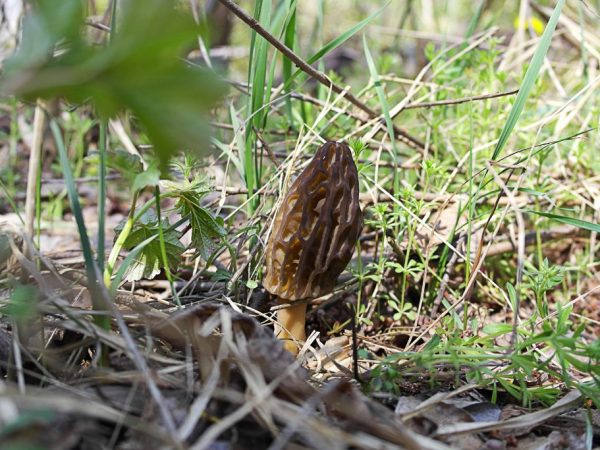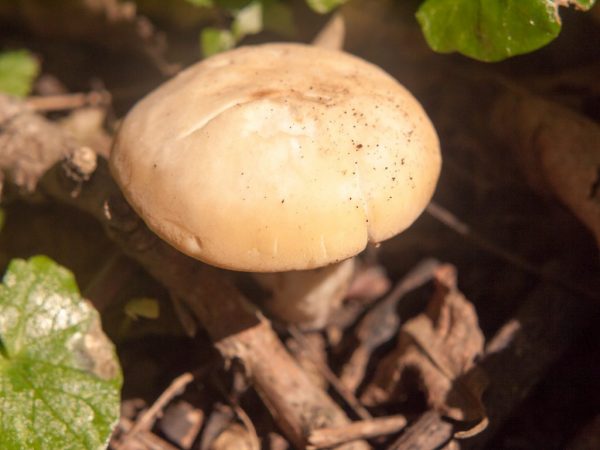Edible spring mushrooms
Edible spring mushrooms appear in forests, fields and gardens. Some of them grow only during certain months, while others are available to mushroom pickers all year round.

Edible spring mushrooms
Mushroom picking time in spring
From the moment the snow melts, conditions appear for the development of mycelium.
Fruiting bodies begin to develop when the air temperature is constantly kept at a level not lower than 7-10 ° C. The necessary conditions are also soil moisture and warming up. Spring is characterized by variability of weather, because many species begin to develop only at the end of the season.
If the winter was warm, then the first spring mushrooms may appear in February. This often happens in the southern regions of the country. In the northern regions, the "quiet hunt" begins only in late April or early May. The middle zone of Russia is known for collecting the first spring mushrooms in March and April.
The very first mushrooms to appear in spring are inedible specimens. They are thinner and more fragile in appearance, have an unattractive smell. But after the toadstools, fruit bodies grow, used for cooking and pickling. The main task of the mushroom picker is to collect young representatives of the species and not touch the old, overgrown ones. Last year's and winter mushrooms, during their stay under the snow, absorb a lot of toxins and are not suitable for food.
March
The first edible spring mushrooms grow in March, even before the snow cover completely disappears.
They are distinguished by their small size and original appearance. They are looked for in the forests, where the sun warms the glades and tree trunks.
Each March first spring mushroom has its own characteristics:
- Auricularia auricular, Judas ear, black wood muer: all these different names belong to the same species, the fruiting bodies of which are found on old slender alders and elderberries. It has a wide, conical, irregular head with a depression in the middle, and a thin long stem. It has a dark color, more often gray-black, with a large amount of precipitation it becomes wet to the touch. Grows in groups of 4-10 individuals.
- Sarkoscifa cinnabar red: it is popularly called "bear ears". Outwardly, it attracts with the unusual shape of the fruiting body, reminiscent of a bowl with rounded or smoothly curved walls. The color is bright red, so it is immediately visible against the gray earth. Groups of sarcoscifs grow on rotten trees, old branches in places with a high concentration of forest compost.
- Gigrofor March (early), or snow mushroom: prefers high ground with good lighting. Grows under last year's fallen leaves. The height of the leg rarely exceeds 5 cm, the width of the cap can reach 7 cm. The fruiting body is dense, thick, with a horizontal convex cap of dark brown or dark gray color. The leg is white-gray, scaly, light gray plates.
- Morel cap: outwardly differs from its relative morel. The upper part of the fruiting body is separated from the stem, has a pleasant brown tint, wrinkled like a dried pear, conical. The leg is longer, thicker, beige and white.It grows under deciduous cover, often aspen or alder, prefers moist lowlands, often located in puddles.
- Conical cap: resembles a morel cap, but outwardly is characterized by the absence of grooves on the upper part of the fruiting body. The color scheme is the same as that of the previous mushroom. This species has no plates or spongy pores, and the shape of the cap is often irregular and curved. It grows in soils with a high moisture content, on calcareous soil among bushes or in hedges. Appears closer to the time of development of morels.
Irina Selyutina (Biologist):
The morel cap belongs to the Morshell family (Morels) and is a representative of the Verpa genus, or Cap. The mushroom got its name due to the similarity with real morels, as well as the way the cap is located on the leg.
- Leg: smooth, curved, often flattened from the sides, can reach a length of 6-10 cm and a thickness of 1.5-2.5 cm. The color is cream or white. The surface is covered with small scales of the same color as the leg itself. In young specimens, the leg is whole, but as the fungus grows, it becomes hollow.
- Hat: bell-shaped, vertically folded. The color changes as the fungus grows: in young mushrooms it is almost chocolate, but in mature ones it is ocher-yellow. It is located on the leg freely, connecting with it only at the base (at the top point). The height of the cap-cap is about 2-5 cm, and about 2-4 cm in diameter. The color of the cap changes as the mushroom matures: from brownish chocolate in youth to buffy yellowish in adulthood.
- Pulp: waxy in appearance. Like the morels, the morel cap can be boiled and fried.
For its development, the mushroom prefers deciduous, especially aspen forests, where in some places it can be found very abundantly.
March is the first month of spring and the most non-mushroom month. Only at the end of March, when the first flowers appear, can you go out in search of snowdrop mushrooms. But still, they will appear more massively only in the month of April.
April

Spring mushrooms taste good
In the second month of spring, the weather is much warmer, and therefore more species of spring mushrooms appear. They occupy not only forest clearings and stumps, but grow in fields, parks and even gardens. Edible April spring mushrooms have a pleasant taste and aroma.
The characteristics of the varieties and their habitat are described in the table below.
| Mushroom name | Description of the fruiting body | Place of growth |
| Giant stitching, Bunched stitching | Irregularly shaped beige and brown hat with deep grooves and dents, resembling a brain in appearance. Giant morel can reach 12-15 cm in diameter. The leg is thin and is located underground. | Pine forests with sandy soil, mixed forests. Grows on the remains of rotten wood and leaves. |
| Morel conical | The body is small in size and cylindrical in shape. The cap is a marsupial, with deep dents resembling a honeycomb, has a light or dark brown color, fits snugly to the lower part - the leg. The leg is white, low, porous inside. | Coniferous forests with rare alders, aspens, birches on the soil with a high sand content. Selects illuminated places - meadows, edges. |
| Oyster mushrooms | Shell-like caps with edges curled inward. The width of the upper part sometimes reaches 17-18 cm. The leg is thin, unable to hold the entire mass. The color changes from gray to ashy with purple. Older specimens fade to white. | Any substrates, rotten wood, old branches, tall stumps. |
| Spring honey mushroom | Small spherical caps with thin legs. The color scheme is brown and beige-brown. There is a girdle on the leg (the remains of a private veil), below its fruiting body is covered with scales. It grows in groups, sometimes growing together with the edges of the fruiting bodies and forming aggregates. | Wood sawdust, rotten branches, stumps. Prefers moist places in the grass. Found in meadows, in the garden, in the forest. |
May
The last month of the season is famous for its edible spring mushrooms, which continue to grow in summer and even autumn. They are more familiar to mushroom pickers and are common throughout the country. In May, the species appear after rain on warm days, when there are no sudden changes in temperature and frost.
Morel is considered the first marsupial mushroom in taste. Its appearance is the same as that of the earlier conical morel, only it has a whitish coating on the edges of the cap. Morels grow on sandy soil of pine and mixed forests, in places with good sunlight. In good weather, the fruiting bodies of the spring mushroom can be harvested in gardens and lawns.
In shady, humid places, the May ridge grows, the second name of which is the Georgiev mushroom. The hat is flat, with a bulge in the center, or humped. The color of the young ryadovka is white or cream. It grows in sunny glades in the forest, in the garden, in the grass along the edges of fields and roads.
The gourmet mushroom entoloma garden is also called thyroid rosacea. It grows under fruit trees - apricots, apple trees, cherries; it can be harvested under thorn and hawthorn bushes. The shape of the cap is flat and conical, up to 10 cm in diameter, the leg can reach 12 cm in height. The color of the fruiting body is brown, the spore plates are pink. Has a flour smell, is placed in groups in the grass.
Irina Selyutina (Biologist):
Garden entoloma can be found not only in the garden, but also in mixed or deciduous forests. It produces several short layers of fruiting bodies during its entire growing season. The fungus is rarely found alone, usually growing in groups. You can find fruiting bodies from May to the end of July.
It is characterized by the presence of an edible twin: pale brown entoloma. This species is found on lawns, gardens and bushes. However, the time when it can be collected is very short: the end of May-June. Very often mushroom pickers, especially beginners, confuse these types of edible entoloma with a poisonous representative of the genus Entoloma - poisonous or pewter entoloma.
Many species are considered conditionally edible or of little value due to their unpleasant taste - deer mushroom, tinder fungus, gnomer, etc. But there are also valuable specimens. Under oak, aspen, birch and other trees in forests and parks, you can find early boletus, white, summer mushrooms in May. Champignons and raincoats appear in the fields and lawns.
Conclusion
From March to early June, many poisonous spring species of mushrooms grow, which novice mushroom pickers easily confuse with edible ones and eat, which leads to poisoning. In such cases, the person has to be reanimated. Therefore, the mushroom picker needs to be careful, collect only familiar spring species, choose ecologically unpolluted (clean) territories and not visit the neighborhood of roads and railways, landfills and landfills, sanitary zones of industrial enterprises for collection.



